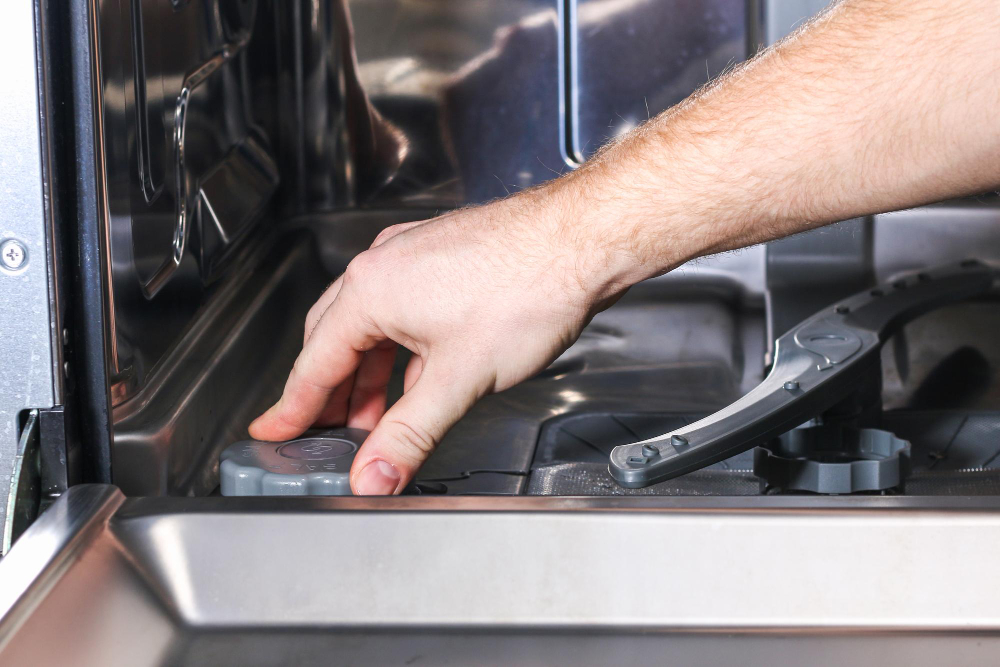Is your dishwasher causing more water damage than you bargained for? Don’t worry, we’ve got you covered with our step-by-step guide to unclogging your dishwasher! With just seven simple steps, you’ll be saying goodbye to those pesky leaks and hello to sparkling clean dishes in no time.
Nobody wants to deal with water flooding their kitchen or ruining their floors, and a clogged dishwasher can be a major culprit. That’s why it’s important to tackle the issue head-on and resolve those blockages before they cause any more damage. Our guide will walk you through the process, from identifying the problem to implementing the solution.
We understand the frustration of dealing with a malfunctioning dishwasher, and that’s why we’ve designed this guide to be straightforward and easy to follow. No fancy tools or advanced plumbing skills required! With our simple steps, you’ll have your dishwasher running smoothly and efficiently, preventing future water damage.
Say goodbye to water damage and hello to hassle-free dishwashing. Let’s dive into our step-by-step guide and get your dishwasher back in working order!
Common causes of dishwasher clogs
Dishwashers are designed to make our lives easier by cleaning our dishes, but they can also be prone to clogging. Understanding the common causes of dishwasher clogs is the first step in preventing and resolving these issues.
One of the primary culprits of dishwasher clogs is food debris. As we load our dishes into the dishwasher, small bits of food can become dislodged and accumulate in the various nooks and crannies of the appliance. Over time, this buildup can block the drainage system, leading to water backups and potential leaks.
Another common cause of dishwasher clogs is the accumulation of grease and oil. When we wash dishes that have been used to cook or prepare greasy foods, the residue can stick to the dishwasher’s interior components, eventually clogging the drainage system. This is particularly problematic in areas with hard water, as the minerals in the water can further contribute to the buildup of grime and debris.
In addition to food and grease, dishwasher clogs can also be caused by the improper use of dishwasher detergents or the presence of foreign objects, such as silverware or small utensils, that have fallen into the dishwasher’s drainage system. These factors can all lead to the formation of blockages that prevent the efficient drainage of water and the proper functioning of the appliance.
Signs of a clogged dishwasher
Recognizing the signs of a clogged dishwasher is crucial in addressing the issue before it leads to more serious problems. One of the most obvious indicators of a clogged dishwasher is the presence of standing water in the appliance after a wash cycle. If you notice that the water is not draining properly or that it’s taking an unusually long time for the dishwasher to empty, it’s a clear sign that there’s a blockage in the drainage system.
Another common sign of a clogged dishwasher is the presence of dirty or cloudy water in the appliance. This can be a result of the water not being able to properly drain, leading to a buildup of debris and residue. Additionally, if you notice that your dishes are not coming out as clean as they usually do, it could be an indication that the dishwasher’s spray arms or nozzles are obstructed, preventing the water from reaching all the necessary areas.
In some cases, a clogged dishwasher may also produce strange noises, such as gurgling or humming sounds, as the appliance struggles to clear the blockage. These auditory cues can be an early warning sign that something is amiss and that it’s time to investigate and address the issue.
If left unattended, a clogged dishwasher can lead to more serious problems, such as water leaks or even the complete failure of the appliance. By recognizing the signs of a clogged dishwasher early on, you can take proactive steps to resolve the issue and prevent further damage to your kitchen and home.

Step 1: Remove any visible debris from the dishwasher
The first step in unclogging your dishwasher is to remove any visible debris that may be causing the blockage. This can be done by carefully inspecting the interior of the appliance and removing any large objects or food particles that you can see.
Start by opening the dishwasher and removing the bottom rack. This will give you better access to the interior of the appliance and allow you to see any obvious blockages. Use a flashlight to thoroughly inspect the different components, such as the spray arms, the drain filter, and the drain hose.
If you notice any large pieces of food, utensils, or other foreign objects, carefully remove them using a pair of tongs or a pair of pliers. Be gentle and avoid using excessive force, as you don’t want to damage any of the dishwasher’s internal parts.
Once you’ve removed the visible debris, it’s important to thoroughly clean the interior of the dishwasher. Use a damp cloth or a soft-bristled brush to wipe down the walls, the racks, and any other accessible areas. This will help to remove any remaining food particles or residue that could contribute to future clogs.
By taking the time to remove any visible debris and clean the interior of the dishwasher, you’re laying the groundwork for the subsequent steps in the unclogging process. This initial step is crucial in ensuring that the rest of the process goes smoothly and effectively.
Step 2: Check and clean the dishwasher filter
One of the most common causes of dishwasher clogs is a dirty or clogged filter. The dishwasher filter is responsible for trapping food particles and other debris, preventing them from entering the drainage system and causing blockages.
To check and clean the dishwasher filter, start by locating it. The filter is typically located at the bottom of the dishwasher, either in the center or along the sides. Consult your dishwasher’s user manual if you’re unsure of its exact location.
Once you’ve found the filter, carefully remove it from the dishwasher. Depending on the model, the filter may twist or lift out. Inspect the filter closely and look for any visible debris or buildup. If the filter appears dirty or clogged, it’s time to clean it.
To clean the dishwasher filter, start by running it under warm water, using a soft-bristled brush or your fingers to gently scrub away any accumulated grime or food particles. Avoid using harsh abrasives or cleaning agents, as they can damage the filter.
If the filter is particularly stubborn or difficult to clean, you can soak it in a mixture of warm water and white vinegar for about 30 minutes. The vinegar will help to break down and dissolve any stubborn deposits. Once the filter is clean, rinse it thoroughly and place it back into the dishwasher, making sure it’s securely in place.
Regular cleaning of the dishwasher filter is an important step in maintaining the overall health and performance of your appliance. By keeping the filter clean, you can help to prevent future clogs and ensure that your dishes come out sparkling clean every time.
Step 3: Clear clogs in the dishwasher drain hose
Another common cause of dishwasher clogs is a blockage in the drain hose. The drain hose is responsible for carrying the dirty water from the dishwasher to the home’s main drainage system, and if it becomes clogged, it can lead to water backups and other issues.
To clear any clogs in the dishwasher drain hose, start by locating the hose. It’s typically located at the back of the dishwasher and may be connected to the sink’s drain or a separate drainage system.
Once you’ve identified the drain hose, disconnect it from the dishwasher and the drainage system. Carefully inspect the hose for any visible blockages or debris. If you can see a clog, try to remove it using a pair of pliers or a small, flexible tool, such as a wire coat hanger.
If the clog is not visible or you’re unable to remove it manually, you may need to use a drain cleaner or a plumber’s snake to clear the blockage. Be sure to follow the manufacturer’s instructions for the drain cleaner or plumber’s snake, and always wear protective gloves and eye wear when working with these tools.
After clearing the clog, rinse the drain hose thoroughly with water to ensure that all debris has been flushed out. Once the hose is clean, reattach it to the dishwasher and the drainage system, making sure that the connections are secure.
By taking the time to clear any clogs in the dishwasher drain hose, you’ll be helping to restore the proper flow of water and prevent future issues with your dishwasher. This step is an important part of the overall unclogging process and should not be overlooked.

Step 4: Use vinegar and baking soda to unclog the dishwasher
If the previous steps haven’t been able to fully clear the clog in your dishwasher, it’s time to try a more natural and effective solution: vinegar and baking soda. This simple, yet powerful combination can help to break down and dissolve even the toughest blockages.
To start, pour one cup of white vinegar into the dishwasher’s detergent dispenser or directly into the bottom of the appliance. The vinegar will help to break down any organic matter that may be contributing to the clog.
Next, sprinkle one cup of baking soda into the dishwasher, either directly into the bottom of the appliance or through the detergent dispenser. The baking soda will react with the vinegar, creating a fizzing and bubbling action that can help to dislodge and flush out any remaining debris.
Once you’ve added the vinegar and baking soda, let the mixture sit for about 15-20 minutes to allow it to work its magic. During this time, you can run a hot water tap in your sink to help heat up the water in the dishwasher, as the heat will enhance the effectiveness of the vinegar and baking soda.
After the waiting period, run the dishwasher through a normal wash cycle. The combination of the vinegar, baking soda, and hot water should help to clear any remaining clogs and leave your dishwasher’s drainage system clean and free-flowing.
This simple, yet effective method is a great way to tackle stubborn dishwasher clogs without the need for harsh chemicals or expensive plumbing tools. Plus, the vinegar and baking soda are both environmentally friendly and safe for your dishwasher and your family.
Step 5: Clean the dishwasher spray arms and nozzles
Another potential source of dishwasher clogs is the buildup of debris on the spray arms and nozzles. These components are responsible for distributing the water and detergent throughout the dishwasher, and if they become clogged, it can lead to poor cleaning performance and even water backups.
To clean the dishwasher spray arms and nozzles, start by removing them from the appliance. Consult your dishwasher’s user manual for instructions on how to properly remove these components. In most cases, you’ll need to unscrew or twist the spray arms to detach them.
Once the spray arms and nozzles are removed, inspect them closely for any visible debris or buildup. Use a small, soft-bristled brush or a toothpick to gently scrub away any grime or food particles that may be clogging the holes or nozzles. Avoid using anything too abrasive, as you don’t want to damage the delicate components.
If the spray arms and nozzles are particularly stubborn, you can soak them in a mixture of warm water and white vinegar for about 30 minutes. This will help to break down and dissolve any persistent buildup. Once they’ve soaked, rinse the components thoroughly under running water to ensure that all the debris has been removed.
After cleaning the spray arms and nozzles, carefully reattach them to the dishwasher, making sure they’re securely in place. Run a test cycle to ensure that the water is properly distributed throughout the appliance and that there are no longer any blockages.
Keeping the dishwasher’s spray arms and nozzles clean is an important part of maintaining the overall health and performance of the appliance. By taking the time to address this potential source of clogs, you can help to prevent future issues and ensure that your dishes come out sparkling clean every time.
Step 6: Run a hot water cycle to flush out remaining debris
Once you’ve completed the previous steps to unclog your dishwasher, it’s a good idea to run a hot water cycle to help flush out any remaining debris or residue. This final step will help to ensure that your dishwasher is fully cleared and ready to operate at its best.
Start by running a hot water tap in your sink to heat up the water. You want the water to be as hot as possible, as the heat will help to break down and dissolve any lingering blockages.
Next, pour about a cup of white vinegar into the dishwasher’s detergent dispenser or directly into the bottom of the appliance. The vinegar will help to further break down and flush out any remaining debris.
With the hot water running and the vinegar added, start the dishwasher on a normal wash cycle. The combination of the hot water and the vinegar will work together to effectively clear out any remaining clogs or blockages in the dishwasher’s drainage system.
If you notice that the water is still not draining properly or that there are still signs of a clog, you may need to repeat this step a few times to ensure that the dishwasher is fully cleared. Patience and persistence are key when it comes to addressing stubborn dishwasher clogs.
Once the hot water cycle is complete, take a moment to inspect the dishwasher and ensure that the water is draining properly and that there are no signs of any remaining debris or blockages. If everything looks good, you can rest assured that your dishwasher is now unclogged and ready to provide you with sparkling clean dishes for the foreseeable future.

Step 7: Regular maintenance tips to prevent future clogs
Now that you’ve successfully unclogged your dishwasher, it’s important to take steps to prevent future clogs from occurring. Regular maintenance and cleaning can go a long way in keeping your dishwasher running smoothly and efficiently.
One of the most important things you can do is to be mindful of what you’re loading into the dishwasher. Avoid placing large pieces of food, bones, or other hard objects in the appliance, as these can easily become lodged in the drainage system and cause blockages. Instead, make sure to scrape off any large food particles from your dishes before loading them into the dishwasher.
Another key step in preventing future clogs is to regularly clean the dishwasher’s filter. As we discussed earlier, the filter is responsible for trapping food and debris, and if it becomes clogged, it can lead to drainage issues. Make a habit of checking and cleaning the filter at least once a month, or more often if you notice a buildup of debris.
In addition to the filter, it’s also important to clean the dishwasher’s spray arms and nozzles on a regular basis. Over time, these components can become clogged with mineral deposits and food residue, which can impair the appliance’s ability to effectively clean your dishes. By taking the time to clean these components, you can help to ensure that your dishwasher is operating at its best.
Finally, consider running a dishwasher cleaning cycle every few months. Many modern dishwashers come equipped with a dedicated cleaning cycle that uses a specialized detergent or cleaning solution to thoroughly clean the interior of the appliance. This can help to remove any built-up grime or residue that may be contributing to future clogs.
By following these simple maintenance tips, you can help to prevent future dishwasher clogs and ensure that your appliance continues to perform at its best for years to come. Regular cleaning and attention to detail can go a long way in keeping your kitchen running smoothly and your dishes sparkling clean.
Conclusion
Dealing with a clogged dishwasher can be a frustrating and time-consuming experience, but with the right approach, you can quickly and effectively resolve the issue. By following the seven simple steps outlined in this guide, you’ll be well on your way to saying goodbye to water damage and hello to a properly functioning dishwasher.
Remember, the key to unclogging your dishwasher lies in identifying the root cause of the problem and addressing it systematically. From removing visible debris to cleaning the filter and spray arms, each step plays a crucial role in restoring your dishwasher to its optimal performance.
By taking the time to properly maintain your dishwasher, you can help to prevent future clogs and ensure that your kitchen remains free from the hassle and damage caused by water backups. Regular cleaning and attention to detail will go a long way in keeping your dishwasher running smoothly and your dishes sparkling clean.
Don’t let a clogged dishwasher ruin your day or your home. Follow our step-by-step guide and take control of the situation. With a little elbow grease and a few household items, you can have your dishwasher back in working order in no time. Say goodbye to water damage and hello to a hassle-free dishwashing experience.

